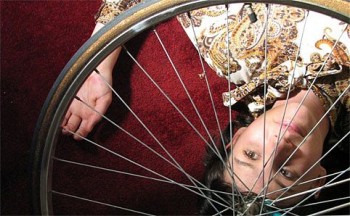Hope is the Saddest – provocative and dark

Marion is intense, socially tactless and lonely. Theo is a confused homosexual, a chronic stoner and a cyclist. Hope is optimistic, naive, and obsessed with Dolly Parton. Brought together through Marion hitting Theo with a car and Hope falling desperately in love with him, delusions and blood are underlining factors in these three vastly differing characters.
The performers were positively chemical with one another. Jeffery’s transformation from laid back to pale and fearful was astounding, while both Michelle and Natalie’s energy as Hope and Marion respectively thrived to such a degree it spilled into the audience. As an ensemble and as individuals, all three were tragically hilarious and likeable in spite of their mild insanities. The dramatic irony employed worked impressively well, enhancing much of the drama and making the comedy explode with electricity on stage.
Fraught with fear, regret and hope beneath the open black humour, the more gritty aspects of the performance were strongly thought-provoking. Although the themes were quite dark and there was a focus on internal delusions, there wasn’t a moment where the audience was uncomfortable or unsure whether to laugh, especially as the drama was occasionally punctuated with spontaneous dance numbers to Dolly Parton music.
Designed to be simple and divided into three for each character, the set and space was well used. Costumes and props were characteristic, as was the diverse backing soundtrack, particularly the unusual and eerie tunes for Marion. Joe Lui’s lighting design melted into the set, using spotlights to illuminate each character’s space and a soft, surreal blue for night scenes. Each technical element was appropriate and subtle to accompany the real driver of the play: the performer’s undeniably hilarious delivery of dialogue.
Movement was sporadically stylised, most notably in Theo’s brief inventing sequence. These silent moments and the disjointed narrating monologues served predominantly to animate the show and give scenes context. Dialogue and the breaking of the fourth wall convention were often ingeniously repetitive, disintegrating the huge differences between the characters and demonstrating their entwined predicaments. The entire play itself was of a cyclical nature, with the first and last scenes echoing in amusing and grim resolution.
Having the audience laughing aloud at the absurdity of the characters and the way their lives crossed in convoluted obscurity, Jeffery Jay Fowler does justice to this return season of his Hope is the saddest. Walking out with the bizarre mixture of verve and thoughtfulness, there was never a dull moment in the play where bleak themes and comedy mingled in seamless harmony to an assortment of Dolly Parton tracks.
